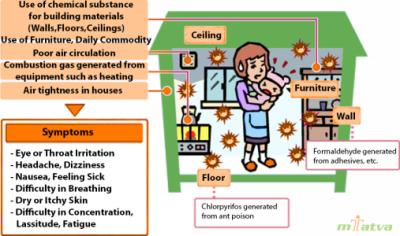
Symptoms
The symptoms on their own or in combination with each other and they may vary from day to day, person to person. They usually improve or disappear altogether after leaving the building.
-
Eye, nose and throat irritation
-
Fatigue (extreme tiredness)
-
Headaches and dizziness
-
Nausea (feeling sick)
-
Aches and pains
-
Difficulty in concentration
-
Coughing, shortness of breath or chest tightness
-
Irritated, blocked or running nose
-
Skin irritation (skin rashes, dry itchy skin)
-
Sensitivity to odours
-
Palpitations
-
Anxiety and depression
-
Constipation or diarrhoea

Causes
Specific causes of this condition are known but possible risk factors for SBS may include
-
Pollutants from motor vehicle exhausts, plumbing vents, and building exhausts (bathrooms and kitchens)
-
Inadequate ventilation
-
Low humidity
-
Tobacco smoke
-
Changes in temperature throughout the day
-
Airborne particles, such as dust, carpet fibres or fungal spores
-
Airborne chemical pollutants, such as those from cleaning materials or furniture, or ozone produced by photocopiers and printers
-
Biological contaminants include pollen, bacteria, viruses, and moulds.
-
Poor hygienic conditions in the working environment
-
Psychological factors, such as stress
-
Poor and inappropriate lightning
Sick building syndrome usually occurs in those employed in buildings containing many people who are working closely together, especially in new buildings with sealed windows.
SBS, ventilation, irritation, Sick Building Syndrome problems, Sick Building Syndrome signs,
Like this:
Like Loading...
Related Articles
Visitor Rating: 5 Stars